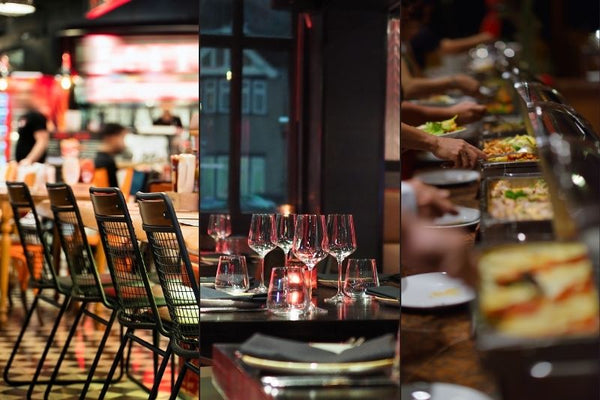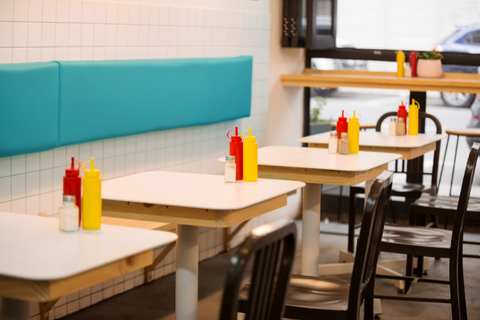Different Types of Restaurants

Restaurants come in many different shapes and sizes. There are different types of restaurants that run the gamut from elegant fine dining establishments to restaurants on wheels, or very informal food service businesses that you wouldn't really think of as a full commercial restaurant kitchen.
Let's break down some of those types of restaurants that you can expect to find in a community known for its food-friendliness.
Fine Dining
This is the crème de la crème of restaurant experiences. Fine dining establishments tend to have an elegant ambiance and feature exotic cuisine along with high-end wine or alcohol options.
Many of them have a formal dress code, as well as a sommelier to recommend fine wines that pair with particular gourmet plates. All of this lends an air of finery to the process of sitting down for a good meal.
Casual Dining
Think of casual dining as the less conspicuous cousin of fine dining. Many casual dining restaurants have moderate prices for entrées and full table service, but not all the bells and whistles that fine dining places are known for – and some people prefer it that way. Casual dining isn’t low on the restaurant food chain, but it accommodates a more informal dining experience.
Contemporary Casual
The contemporary casual category of restaurants innovates on the concept of the traditional casual dining establishment.
While most have table service, others have different alternative models. For instance, modern brew-pubs may have counter service, or partial counter service (i.e. counter orders and food brought to tables), but still, have a pretty upscale menu.
Many of these restaurants also promote themselves visually with neat modern styles and fresh designs to create a better customer experience.
Family-Style Restaurants
Some people might consider this type of restaurant a throwback to the old days of family dining with somewhat old-school menus and shared platters or dishes. These restaurants also tend to have table service and cater to those with young family members.
Fast Casual
The fast-casual restaurant represents a bridge between traditional casual dining and the fast-food franchise.
Like a fast-food restaurant, many fast-casual restaurants have specific franchise agreements in place to control everything from the food menu to the customer experience. But, like casual restaurants, fast-casual establishments will tend to have food that's not just whipped up in a lab, the way that fast food tends to be. In other words, it's a bit less formulaic in terms of creating a menu that feels like something you get in a traditional casual dining environment.
For example, franchise restaurants with rustic soups and bread are an example of elevating the conventional fast food restaurant.
Fast Food Restaurants

Fast food is one of the predominant types of restaurants around the country.
These restaurants tend to pop up in places where travelers need a quick bite to eat, or in high-traffic areas where they can entice passers-by. Many of them operate according to strict franchise agreements so that you always know what you’re going to get.
Café Restaurants
In some ways, the café does compete with the fast-food franchise. Café restaurants will tend to have a bit more elevated options in terms of food, although their menus are often limited. Many of them specialize in coffee and drinks with to-go food such as bagels or other baked goods.
Many cafés tend to be individually run rather than commercially franchised, although that's not the case with brands like Starbucks.
Buffet Restaurant
Buffet restaurants are a traditional style of restaurant service where customers can eat to their heart’s content.
This category of restaurant type even has its own subcategories like Chinese buffets, seafood buffets, and “good old home cooking” buffets. In some cases, there is a crossover to the family restaurant type.
Buffets started to close during the coronavirus pandemic, but some are now reopening to allow visitors the opportunity to load their plates with whatever they see behind the sneeze guard.
Food Trucks and Concession Stands
Food trucks and concession stands often need municipal permission in order to operate. Being mobile, they may float from one retail location to the next, popping up at places like country fairs, farmers’ markets, or even alongside any road.
Pop-Up Restaurants

This type of retail is a strategic way to make money on foodservice, without spending the exorbitant amounts of money that you need for a traditional restaurant kitchen.
But pop-ups still need a range of equipment and gear. They might, for example, rent these things from a different established restaurant and operate right over the other restaurant’s counter during off-hours. Others use a different shared kitchen arrangement.
Ghost Kitchens
New food delivery services driven by the internet and mobile phones helped to develop this new restaurant category called the ‘ghost kitchen.’
In a ghost kitchen, a crew works to deliver food through a white label process. In other words, when that food gets to the diner, it's not branded by the ghost kitchen itself, but by some other entity, and it’s subject to some complex delivery process.
If you’re thinking about setting up any of these great categories of restaurants, get everything that you need to operate from Chefs’ Toys, a trusted supply firm where we are “for chefs by chefs” and have your success in mind!






















